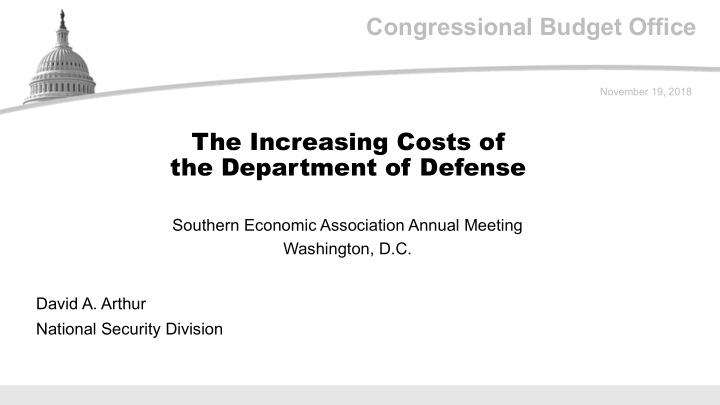



Congressional Budget Office November 19, 2018 The Increasing Costs of the Department of Defense Southern Economic Association Annual Meeting Washington, D.C. David A. Arthur National Security Division
CBO Historical Funding and Projected Costs for the Department of Defense (DoD) DoD’s 2019 Future Years Defense Program (FYDP) describes its budget plans through 2023. CBO’s most recent projection of DoD’s costs beyond that “FYDP period” is based on DoD’s 2018 goals. Sources: Department of Defense, National Defense Budget Estimates for 2019 ; Congressional Budget Office, Analysis of the Long-Term Costs of the Administration’s Goals for the Military (December 2017), www.cbo.gov/publication/53350. 1
CBO Historical Funding and Projected Costs for the Department of Defense, Normalized for Changes in the Size of the Military Sources: Department of Defense, National Defense Budget Estimates for 2019 ; Congressional Budget Office, Analysis of the Long-Term Costs of the Administration’s Goals for the Military (December 2017), www.cbo.gov/publication/53350. 2
CBO Historical Funding and Projected Costs of 2019 Plans, by Category of the Defense Budget (Base Budget Only) Sources: Department of Defense, National Defense Budget Estimates for 2019 ; Congressional Budget Office, Analysis of the Long-Term Costs of the Administration’s Goals for the Military (December 2017), www.cbo.gov/publication/53350. 3
CBO Three Major Contributors to the Increasing Cost of Defense Costs for compensation of military personnel — including health care benefits for active- duty and retired service members — have been rapidly increasing since 2000. Costs of operation and maintenance per active-duty service member have been steadily increasing since at least 1980. New weapon systems tend to be more expensive than the ones they replace. 4
CBO Sources of Growth in Military Personnel Costs, Fiscal Years 2000 to 2014 Costs grew even as the number of military personnel decreased 2 percent from 2000 to 2014. Similar growth has continued since 2014. Source: Congressional Budget Office, Growth in DoD’s Budget From 2000 to 2014 (November 2014), www.cbo.gov/publication/49764. Costs are shown in 2014 dollars. 5
CBO Operation and Maintenance (O&M) Costs per Active-Duty Service Member O&M includes the cost of most DoD civilians’ salaries, goods and services, fuel, maintenance, and contractors. The rate of increase in these costs has been higher since 2001. They nearly tripled from 1980 to 2017. Source: Congressional Budget Office, An Analysis of the Obama Administration’s Final Future Years Defense Program (April 2017), www.cbo.gov/publication/52450. 6
CBO Some Sources of Growth in Operation & Maintenance Costs, 2000 to 2014 Source: Congressional Budget Office, Growth in DoD’s Budget From 2000 to 2014 (November 2014), www.cbo.gov/publication/49764. Costs are shown in 2014 dollars. 7
CBO Projected Costs of the Military Health System Military health care costs have approximately doubled since 2000. Source: Congressional Budget Office, An Analysis of the Obama Administration’s Final Future Years Defense Program (April 2017), www.cbo.gov/publication/52450. 8
CBO Unit Costs for Weapon Systems Are Rising Technological sophistication has grown. For instance, compare the B-52 bomber with the B-2 stealth bomber. Purchase quantities have fallen to equip a smaller force. For instance, there were 101 attack submarines and 39 ballistic missile submarines in 1986; today, there are 52 attack submarines and 18 ballistic or cruise missile submarines. Purchase rates have fallen. During the 1980s, the military bought 355 fighters per year, on average; 105 per year are currently planned for the F-35. 9
CBO An Example of Growth in Weapon Acquisition: The Navy’s Shipbuilding Program CBO estimates that the Navy’s 2019 shipbuilding plan will cost more than the Navy estimates. The plan would fall short of meeting the service’s inventory goal for some types of ships. Historical average funding would be insufficient to cover the shipbuilding contained in the plan. Source: Congressional Budget Office, An Analysis of the Navy's Fiscal Year 2019 Shipbuilding Plan (October 2018), www.cbo.gov/publication/54564. 10
CBO Average Annual Costs of New-Ship Construction Under the Navy’s 2019 Plan Source: Congressional Budget Office, An Analysis of the Navy's Fiscal Year 2019 Shipbuilding Plan (October 2018), www.cbo.gov/publication/54564. 11
CBO The Broader Context: Deficits or Surpluses Under CBO’s Baseline Projections Percentage of Gross Domestic Product Source: Congressional Budget Office, The Budget and Economic Outlook: 2018 to 2028 (April 2018), www.cbo.gov/publication/53651. 12
CBO Contexts for Thinking About the Size of the Defense Budget Sources: Congressional Budget Office; Department of Defense, National Defense Budget Estimates for 2019 ; Stockholm International Peace Research Institute, SIPRI Military Expenditure Database , www.sipri.org/databases/milex. 13
CBO Possible Responses to the Increasing Cost of Defense Do nothing. Accept current defense strategies, plans, and costs as generally appropriate and necessary for today’s international security environment. Try to find savings in specific areas. – Slow the growth of pay and benefits. – Reform how weapons are developed and purchased. – Reduce overhead. Constrain DoD’s overall budget and let internal forces find the savings. Scale back the role of military force in the national security strategy. 14
Recommend
More recommend